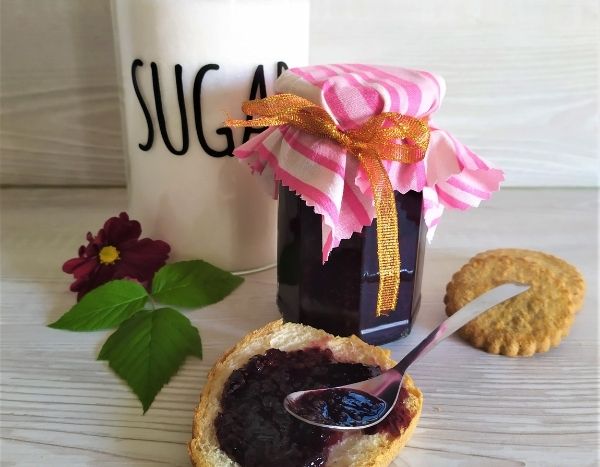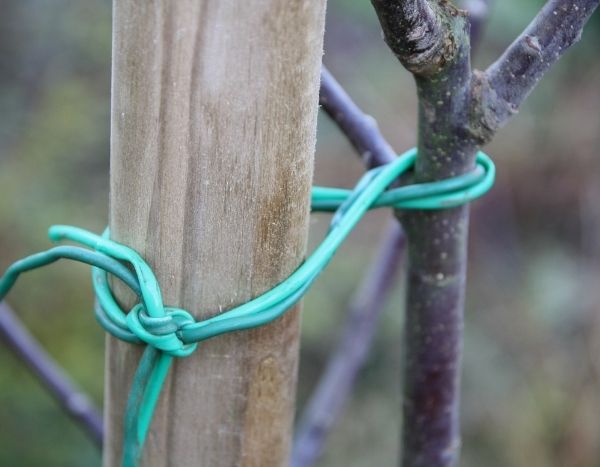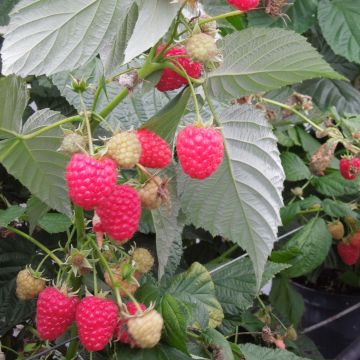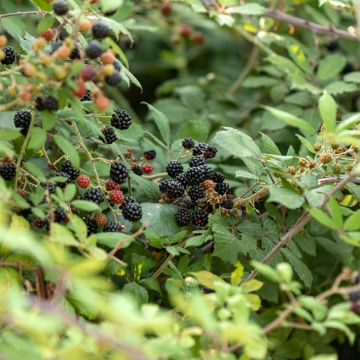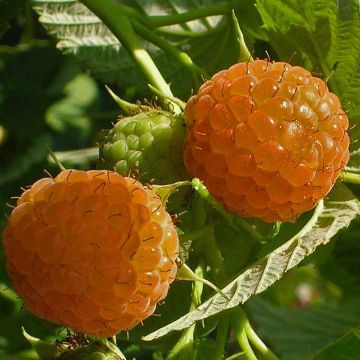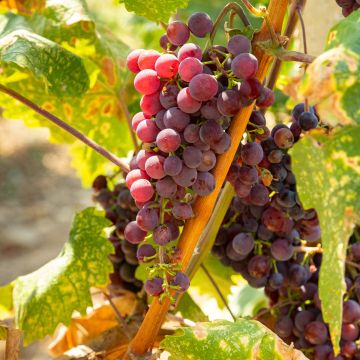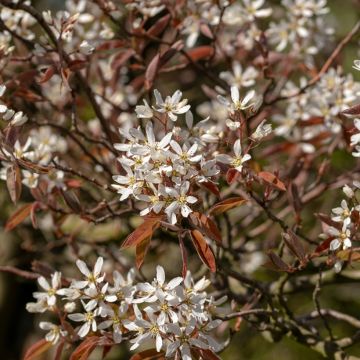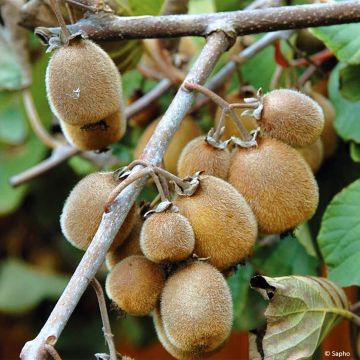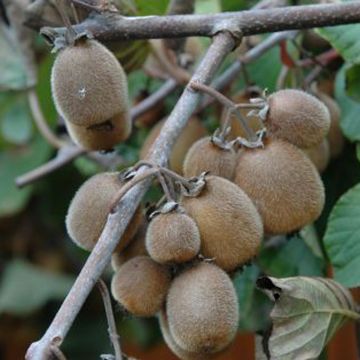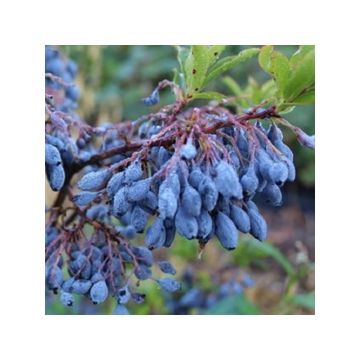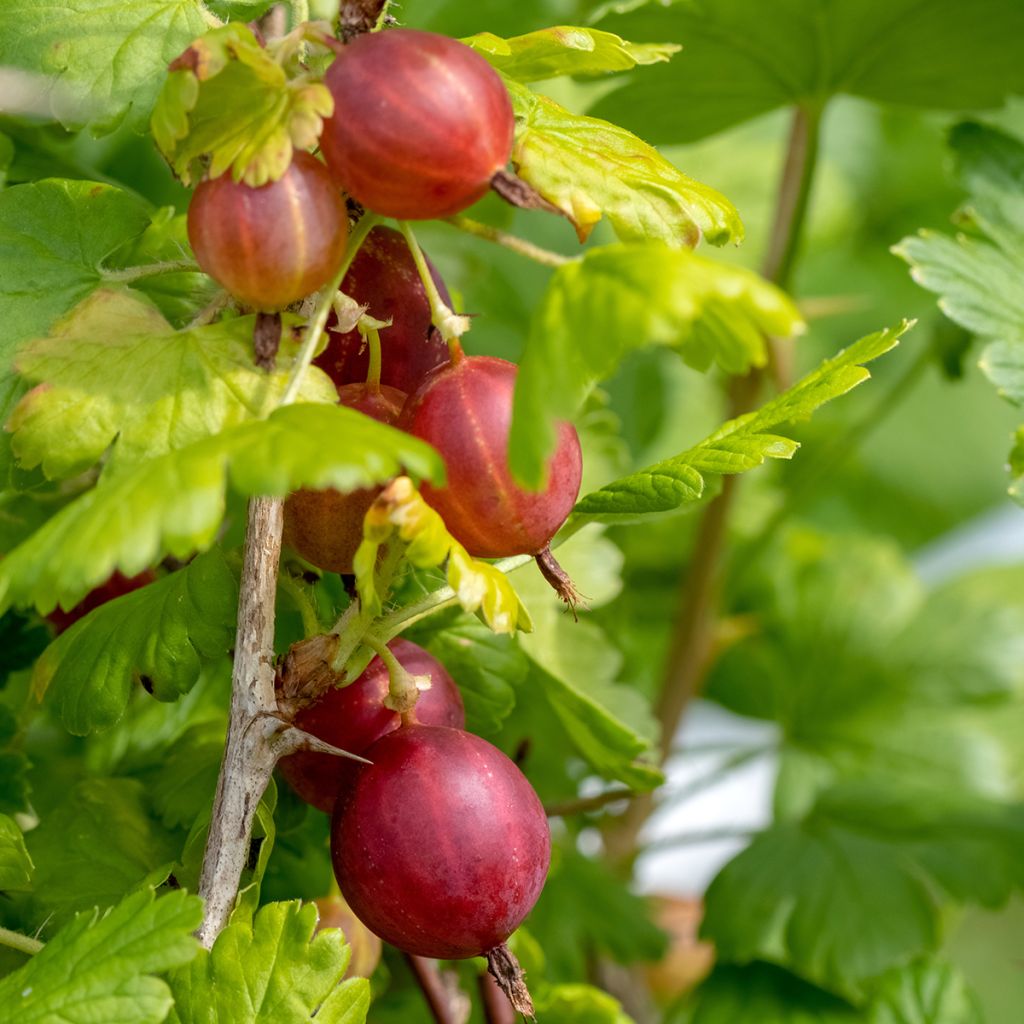

Uva-spina Easycrisp Lady Late
Uva-spina Easycrisp Lady Late
Ribes uva-crispa Easycrisp ® Lady Late ®
Uva-spina, Ribes Uva-spina
Operazione speciale!
Ricevi un buono acquisto di 20 € per ogni ordine superiore a 90 € (escluse spese di spedizione, buoni e opzione senza plastica)!
1- Aggiungi le tue piante preferite al carrello.
2- Una volta raggiunti i 90 €, conferma l'ordine (puoi anche scegliere la data di consegna!).
3- Non appena il tuo ordine sarà spedito, riceverai un'e-mail contenente il codice del tuo buono acquisto, valido per 3 mesi (90 giorni).
Il tuo buono è unico e utilizzabile una sola volta, per qualsiasi ordine di importo minimo di 20 €, escluse le spese di spedizione.
Cumulabile con altre offerte in corso, non divisibile e non rimborsabile.
Consegna a domicilio o a staffetta (a seconda delle dimensioni e della destinazione)
Programmare la data di consegna,
e scegliere la data nel carrello
6 mesi garanzia di permuta su questa pianta
Altre informazioni
Garantiamo la qualità delle nostre piante per un intero ciclo di crescita e sostituiremo a nostre spese qualsiasi pianta che non si riprenda nelle normali condizioni climatiche e di impianto.
Descrizione del prodotto
Il Ribes rosso Easycrisp ® ‘Lady Late’ ® è una recente selezione che si distingue per i suoi rami quasi privi di spine con l'età, per la sua produzione regolare ed elevata di frutti senza peli, succosi, dal sapore dolce e fruttato, e per la sua crescita sana, nonché la sua buona tolleranza all'oidio. In estate, i frutti del ribes rosso sono deliziosi e possono essere utilizzati per insaporire insalate, piatti salati o dessert. Ad aprile, i suoi fiori bianco verdastri, un po' insignificanti, sono una fonte di cibo per le api e altri insetti utili. Una esposizione soleggiata e un terreno ricco di nutrienti sono necessari per un'ottima raccolta. Questo arbusto è relativamente poco esigente e resistente alle malattie. Può essere coltivato in piena terra o in vasi. Facile da mantenere e generoso, porta piacere e incanto al giardino. Piantumazione da ottobre a marzo per una raccolta in luglio-agosto.
Il Ribes rosso, in latino Ribes grossularia var. uva-crispa, chiamato anche Ribes spinoso, Uva crespa, Claque-poux, Croque-poux, Ballon o Vinétier, appartiene alla famiglia delle Grossulariaceae, come i Ribes a grappoli (Ribes rubrum) e i Ribes neri (Ribes nigrum). Il nome Ribes rosso deriva dagli inglesi che utilizzavano da molto tempo questo ribes per preparare una salsa agrodolce da accompagnare al merluzzo. Coltivato nel nord Europa fin dal XVI secolo, il Ribes rosso è un ibrido fertile derivante dall'incrocio tra due specie originarie dell'Europa e del Nord Africa, ancora spontanee nelle foreste montane, in Scozia, in Francia e nel Caucaso.
Il Ribes uva-crispa Easycrisp ® ‘Lady Late’ ® è una recente creazione svizzera della gamma Easycrisp ®. Una gamma composta da varietà di ribes selezionate per i loro elevati rendimenti, grandi frutti aromatici e succosi, su piante quasi prive di spine, vigorose e resistenti alle malattie, in particolare all'oidio. Forma un arbusto cespuglioso, poco spinoso, con portamento a ciuffo di rami un po' rigidi, ramificati ed eretti. Questo arbusto molto rustico raggiungerà 1 m di altezza per un'espansione di 80 cm. Il fogliame è caduco, composto da foglie palmate, lobate e aromatiche, di colore verde medio. Questo arbusto assomiglia ai classici ribes, ma si differenzia soprattutto per i frutti: più grandi, dal sapore dolce, compaiono solitari lungo i rami a differenza dei ribes a grappoli. La fioritura avviene in primavera, sotto forma di grappoli di piccoli fiori verdastri insignificanti, intensamente visitati dalle api. La fruttificazione avviene principalmente sui rami di uno e due anni. La raccolta avviene dalla fine di luglio a metà agosto. L'arbusto si copre quindi di grosse bacche, rotonde o ovali, dalla pelle liscia, di 1,4 cm di diametro, distribuite lungo i rami. A maturazione, i ribes assumono un colore rosso vivo e sono pieni di polpa traslucida, succosa, fruttata, dolce e leggermente acidula, contenente minuscoli semi.
Il Ribes rosso Lady Late è autofertile, quindi non ha bisogno di un compagno per fruttificare, ma la presenza di un'altra varietà nelle vicinanze aumenterà la produzione. La raccolta avviene man mano che i frutti maturano. Essa è semplificata grazie alle dimensioni dei grani. La produzione di un ribes è di circa 3-5 kg di frutti per pianta a seconda dell'età e delle condizioni di coltivazione della pianta. I frutti sono ricchi di vitamina C, antiossidanti, minerali, oligoelementi, potassio, calcio e fosforo. Inoltre, il loro basso contenuto di zuccheri li classifica tra i piccoli frutti meno energetici (50 kcal per 100 g). Il frutto è depurativo per l'organismo grazie alle sue proprietà diuretiche, digestive, decongestionanti del fegato e lassative, a condizione di consumarlo leggermente maturo. Raccolti sull'arbusto, sono squisiti da gustare freschi e, per maggior golosità, si possono cospargerli con un po' di zucchero cristallizzato. In cucina, per attenuare l'acidità dei frutti, è possibile sbollentarli per un minuto e poi raffreddarli sotto acqua fredda. Ottimi in gelatine o marmellate, si possono anche utilizzare per guarnire torte e preparare dolci. Saranno perfetti nella produzione di sciroppi, sorbetti, gelati o dessert. L'equilibrio sottile tra gli aromi e l'acidità dei frutti offre un'utilizzo interessante per accompagnare carni (selvaggina, pollame, ...), pesci grassi (sardine, merluzzi, tonni, ...) o per dare un tocco in piccole quantità nelle insalate composte.
In estate, il Ribes rosso Lady Late offre momenti di piacere gustativo con i suoi frutti succulenti. La raccolta è facile poiché le bacche sono grandi e la pianta ha poche spine. Un grande piacere per il palato e una soddisfazione per il raccoglitore. Si può associare a Ribes neri, Lamponi, Mirtilli, Ribes nero o altre varietà di piccoli frutti per formare una siepe commestibile, che saprà rafforzare con i suoi molteplici vantaggi culinari. Come in ogni piantagione, è importante, in una piantagione di ribes, alternare specie e varietà, dove possibile. In questo modo si limita il rischio di malattie e si favorisce l'impollinazione, anche se la varietà è autofertile. È possibile coltivarlo in vaso, ma è necessario scegliere un contenitore alto almeno 40 cm e assicurarsi di annaffiare regolarmente con acqua non calcarea.
Segnala un errore nella descrizione del prodotto
Uva-spina Easycrisp Lady Late in foto...
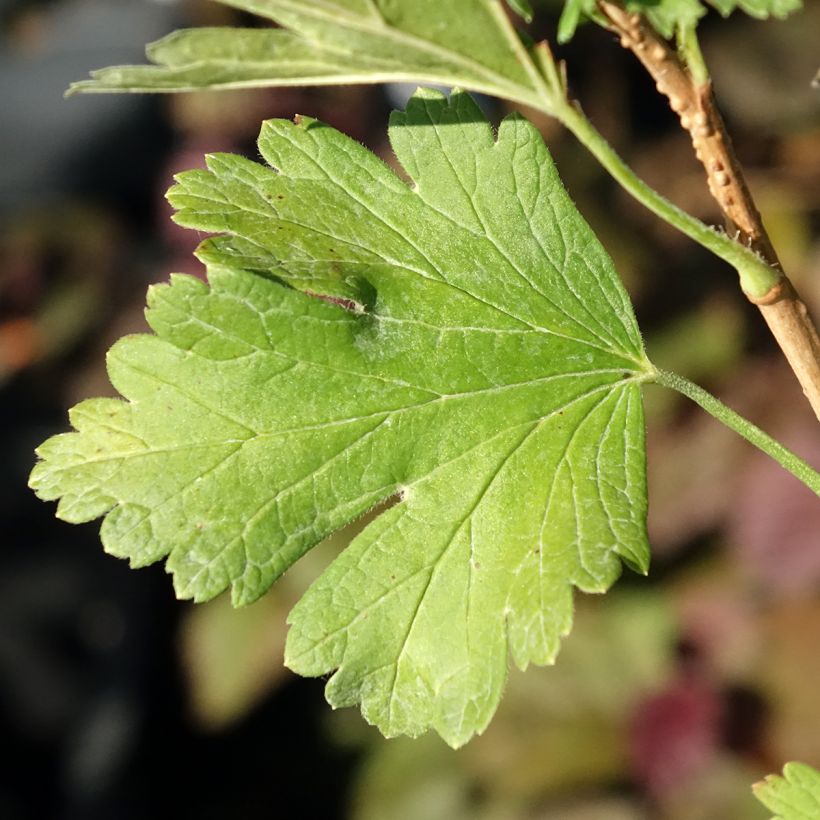

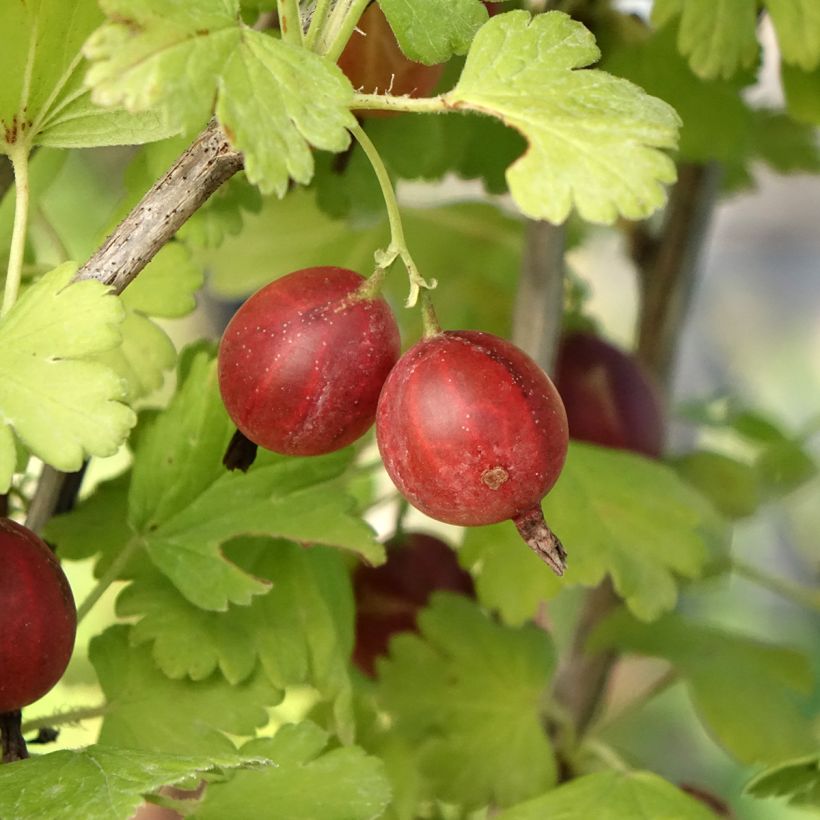

Porto
Frutta
Fioritura
Fogliame
Botanici
Ribes
uva-crispa
Easycrisp ® Lady Late ®
Grossulariaceae
Uva-spina, Ribes Uva-spina
Orticola
Piantagione e cura
Piantate l'Uva spina da ottobre a marzo. Apprezza i terreni comuni, anche poveri, tendenzialmente acidi. L'Uva spina si trova bene in un terreno ben drenato, fresco ma non costantemente umido. Temendo il caldo e la siccità, piantatela al sole nelle regioni a nord della Loira o a mezz'ombra al sud. Scegliete un luogo riparato dai venti forti.
Alla piantagione, spaziate le piante di 0,80 m in tutte le direzioni. Per le piante a radice nuda, immergete le radici in un pralinato, per evitare la formazione di sacche d'aria tra le radici e la terra. Potete preparare il pralinato mescolando 1/3 di terra molto fine o terriccio, 1/3 di letame di vacca o compost e 1/3 di acqua piovana, oppure acquistarlo già pronto. Fate un buco, mescolate al terreno letame ben decomposto o compost maturo, posizionate la pianta e ricoprite di terra. Annaffiate abbondantemente. Successivamente pacciamate il terreno per mantenere la freschezza in estate.
Un apporto di concime organico all'avvio della vegetazione supporterà la produzione di frutti e la salute delle piante. L'Uva spina può essere attaccata da afidi e acari, che possono essere eliminati spruzzando acqua saponata o un decotto d'aglio. È anche soggetta a malattie crittogamiche, dovute ai funghi, come l'antrocinosi (macchie brune sulle foglie e sui frutti), l'oidio (muffa bianca), il grigio (muffa bianca poi marrone sulle bacche) e la ruggine (pustole arancioni sul lato inferiore delle foglie). Spruzzate regolarmente purin d'ortica, di consolida o un decotto di equiseto. Eliminate e bruciate tutte le parti malate. A giugno-luglio, proteggete il raccolto con delle reti per contrastare la golosità degli uccelli.
È importante in una piantagione di uva spina, come in qualsiasi piantagione, alternare le varietà e le specie, quando lo spazio lo permette: la impollinazione sarà favorita e lo sviluppo di epidemie o malattie sarà limitato.
Quando piantare?
Per quale località?
Trattamenti
I nostri consigli per la messa a dimora e la cura
Questo articolo non è ancora stato recensito; sii il primo a condividere la tua esperienza.
Articoli simili
Non hai trovato quello che cercavi?
La rusticità è la temperatura invernale più bassa che una pianta può sopportare senza subire gravi danni o addirittura morire. Tuttavia, la rusticità è influenzata dalla posizione (zona riparata, come un patio), dalla protezione (copertura invernale) e dal tipo di terreno (la rusticità è migliorata da un terreno ben drenato).

Condizioni generali di utilizzo del servizio fotografico per clienti
Al fine di favorire l'interazione e la condivisione di esperienze tra giardinieri, Promesse de fleurs offre diversi servizi che consentono di caricare contenuti sul proprio Sito, in particolare attraverso il modulo "Condivisione foto".
L'Utente si impegna a non:
- Pubblicare contenuti illegali, pregiudizievoli, ingiuriosi, razzisti, che incitano all'odio, revisionisti, contrari alla pubblica decenza, che violano la privacy o i diritti privati di terzi, in particolare il diritto all'immagine delle persone e dei beni, i diritti di proprietà intellettuale o il diritto alla privacy.
- Pubblicare contenuti per conto di terzi.
- Impersonare un terzo e/o pubblicare informazioni personali su un terzo.
In generale, l'Utente si impegna ad astenersi da qualsiasi comportamento non etico.
Tutti i Contenuti (in particolare testi, commenti, file, immagini, foto, video, opere, ecc.), che possono essere oggetto di diritti di proprietà, diritti di proprietà intellettuale, diritti di immagine o altri diritti privati, restano di proprietà dell'Utente, fatti salvi i diritti limitati concessi dalla licenza definita di seguito a Promesse de fleurs. Gli Utenti sono liberi di pubblicare o meno tali Contenuti sul Sito, in particolare tramite il servizio "Condivisione foto", e accettano che tali Contenuti diventino pubblici e liberamente accessibili, in particolare su Internet.
Essi riconoscono, si impegnano e garantiscono di disporre di tutti i diritti e le autorizzazioni necessarie per tale pubblicazione sul Sito, in particolare per quanto riguarda la legislazione in vigore e i diritti di privacy, di proprietà, di proprietà intellettuale, di immagine, contrattuali o di qualsiasi altra natura. Pubblicando tali Contenuti sul Sito, l'Utente è consapevole di assumersi la responsabilità di editore dei Contenuti ai sensi di legge e concede a Promesse de fleurs una licenza non esclusiva, gratuita e mondiale per tali Contenuti, per tutta la durata della loro pubblicazione, compresi i diritti di riproduzione, rappresentazione, caricamento, visualizzazione, esecuzione, trasmissione e archiviazione.
Gli Utenti autorizzano inoltre l'associazione del loro nome al Contenuto e accettano che tale associazione non sia sempre possibile.
Con la loro pubblicazione, gli Utenti autorizzano i Contenuti a diventare automaticamente accessibili su Internet, in particolare su altri siti e/o blog e/o pagine web del sito Promesse de fleurs, comprese in particolare le pagine dei social network e il catalogo Promesse de fleurs.
Gli Utenti possono liberamente ottenere la restituzione dei Contenuti affidati contattando il servizio clienti tramite il modulo di contatto.
I periodi di semina indicati sul nostro sito web si riferiscono a Paesi e regioni all'interno della Zona USDA 8 (Francia, Regno Unito, Irlanda, Paesi Bassi).
Nelle zone più fredde (Scandinavia, Polonia, Austria...), ritardare le semine all'aperto di 3-4 settimane o seminare sotto vetro.
Nei climi più caldi (Italia, Spagna, Grecia, ecc.), anticipare la semina all'aperto di qualche settimana.
Il periodo di raccolta indicato sul nostro sito web si riferisce ai Paesi e alle regioni della zona USDA 8 (Francia, Inghilterra, Irlanda, Paesi Bassi).
Nelle zone più fredde (Scandinavia, Polonia, Austria...) la raccolta di frutta e verdura potrebbe essere ritardata di 3-4 settimane.
Nelle zone più calde (Italia, Spagna, Grecia, ecc.), la raccolta avverrà probabilmente prima, a seconda delle condizioni meteorologiche.
Il periodo di semina indicato sul nostro sito web si riferisce a Paesi e regioni situati nella zona USDA 8 (Francia, Regno Unito, Irlanda, Paesi Bassi).
Varia a seconda del luogo di residenza:
- Nelle zone mediterranee (Marsiglia, Madrid, Milano, ecc.), l'autunno e l'inverno sono i periodi migliori per la semina.
- Nelle zone continentali (Strasburgo, Monaco, Vienna, ecc.), ritardare la semina di 2 o 3 settimane in primavera e anticiparla di 2 o 4 settimane in autunno.
- Nelle regioni montuose (Alpi, Pirenei, Carpazi, ecc.), è meglio piantare in tarda primavera (maggio -giugno) o in tarda estate (agosto-settembre).
Nei climi temperati, la potatura degli arbusti a fioritura primaverile (forsizia, spiree, ecc.) deve essere effettuata subito dopo la fioritura.
La potatura degli arbusti a fioritura estiva (lillà indiano, perovskia, ecc.) può essere effettuata in inverno o in primavera.
Nelle regioni fredde e con piante sensibili al gelo, evitate di potare troppo presto quando possono ancora verificarsi forti gelate.
Il periodo di fioritura indicato sul nostro sito web si riferisce a paesi e regioni situati nella zona USDA 8 (Francia, Regno Unito, Irlanda, Paesi Bassi, ecc.).
Varia a seconda della zona di residenza
- Nelle zone da 9 a 10 (Italia, Spagna, Grecia, ecc.), la fioritura avverrà da 2 a 4 settimane prima.
- Nelle zone da 6 a 7 (Germania, Polonia, Slovenia e regioni montuose inferiori), la fioritura sarà ritardata di 2 o 3 settimane.
- Nella zona 5 (Europa centrale, Scandinavia), la fioritura è ritardata di 3-5 settimane.

































